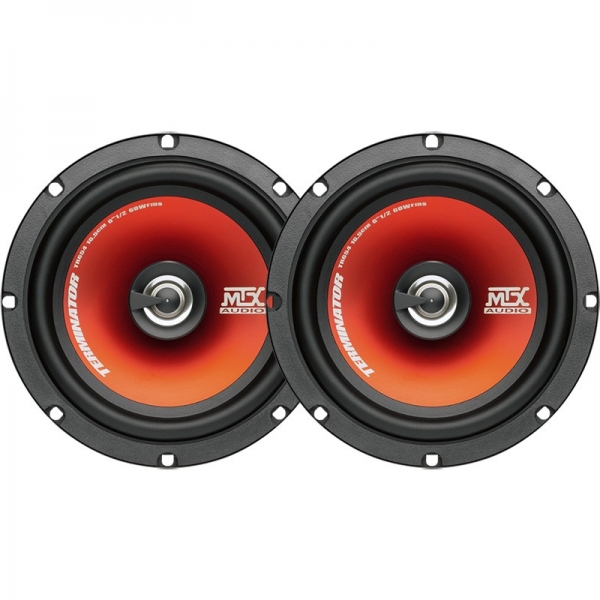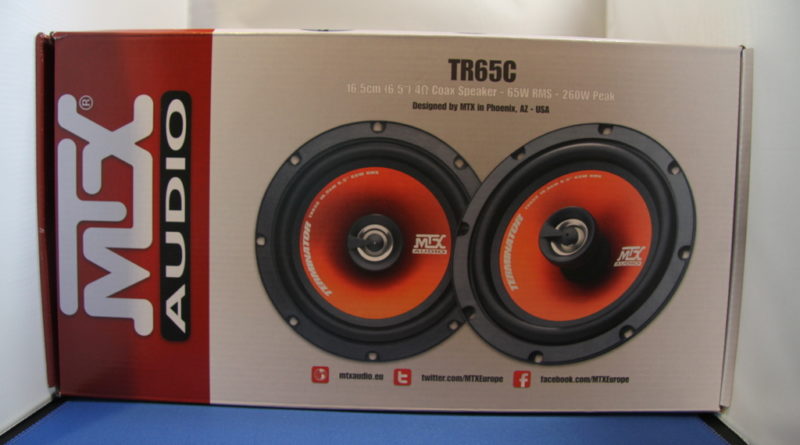MTX Audio TR65C 2-Way Co-Axial Speakers
Manufacturer: MTX Audio
Distributor: Celsus
Website:link
Typical Selling price: £39.99
In A Nutshell
Big performance with great high frequency detail, so will sound cool with dem funky yoof choons. Just not a bass heads’ reggae thing on their own.( MTX make mental bass makers, mind.) Pretty to look at, with branded anodised-looking cones and a nice chunky magnet under both main cone and tweeter. Clean sound quality with control,. Effortlessly better than any single speaker sold in Halfords in my opinion and cretinously a no-brainer decision, priced at £39.99.
Overall 8.2
Sound Quality 7
Build Quality 7
Power 8
Efficiency 9
Value For Money 10
 Editor Review : MTX Audio TR65C 2-Way Co-axial Speakers
Editor Review : MTX Audio TR65C 2-Way Co-axial Speakers
These loudspeakers are part of a group test. Seven different pairs of the most commonly found variety, being coaxial. This means the tweeter is mounted directly in front of the woofer. This pair of MTX Terminator TR65C are rated at 60 W RMS in the specification yet it says 65 W on the cone of the product.
A neatly made yet standard variety of pressed steel chassis contains the moving parts, with a pole through the middle to support the inexpensive yet remarkably high-performance tweeter. This is made of Mylar, one of the Space age materials, like Velcro, developed for space flight. Mylar is actually able to prevent the through-transmission of the tiny Helium atom. This is essential as a layer in spacesuits and is the material that the legendary and now delightfully dated Pack a Mac was fashioned from! Looking at the build quality, there are obvious features that prove the 65 Watt continuous power rating. Yes, you can quadruple that for a lovely peak rating to publish upon the box, but 65 genuine watts is enough to make toast! There is a quite chunky ferrite magnet underneath the main cone, which is dead snazzy and prettily printed. Really cheap and nasty loudspeakers are usually equipped with a tweeter that can look a little like the one on this speaker. However, just like the main cone, look underneath. The MTX Terminator TR65C has another solid wee chunk of ferrite underneath the tweeter. The looky-likey nasties are called Piezo Electric and are skinny as hell. This is a righteous, pukka effort, not Piezo. The very best tweeters on really expensive speakers will have magnets made from what are termed Rare Earth magnets. Samarium-Cobalt, Strontium and in particular, Neodymium are the names of them. These magnets can be a fraction the size of a regular Ferrite, like the ones here. But because it is a genuinely sexy technology, makers who use neodymium magnets, will always either brag about it in the printing on the box or because it is such a special and important material, the very part number of the product may well say ‘˜Neo.’ This is always a good thing.
OK, so much for the education, what are these loudspeakers like? Well, bearing in mind that’s a little bit like her Majesty the Queen, who has the stench of new paints in her nostrils every place she goes, (because everybody applies a new lick of paint before her Majesty arrives do they not?) I am condemned for ever to listen to loudspeakers that are not run in. Yes, like anything with moving parts, the cone assembly of a loudspeaker, will tend to become more bouncy or compliant as you add hours of play. In the poncy end of hi-fi, they discuss run in of everything. I reckon they can hear when cables have been used a lot. (I would not dare try!) This means I rarely get to experience the deeper bass a well-run-in speaker makes. And to be rugged, a speaker has to start out a bit stiffly suspended.
Having seen an awful lot of loudspeakers in a very long career, these look muscular, well made, not stinting upon materials, and with an excellent design appeal. MTX know their customer, and I think these are made to be run on a 4 x 40 or 4 x 50 W amplifier, having its transistor’s spanked off by an enthusiastic nutter. They are that rugged item.
Brief funny aside; do bear in mind I am very lazy and hate doing anything twice. I used a brand-new Morel four channel amplifier, which has excellent features. I connected all the loudspeakers and cables and clips, in the time-honoured jerryrigged fashion. Connected an ancient Kenwood CD player, somehow not really paying attention to the terrible transport noises and hum, only to find that is one channel of the rig just wasn’t working. Always doubting my skills, I unscrewed the offending loudspeaker, to of course find it soundly connected I had failed to simply press ‘˜four Channel use from two channel input’ button. Idiot Then, having neatly connected a blue jumper loop from the live to the remote switching terminal, only of course to then decide I did not want the amp to be permanently on, I cut it and connected at the blue wire from head unit. This was another 10 minute’s worth There is a switch, that you position to use this blue wire remote or else two other kinds of automation. Signal sensing and current sensing on the power means you do not need the blue wire. GAH! Confessing to this idiocy, is merely to prove that you guys always get the whole truth and it’s funny when the so-called expert messes up. Again. And again
I also admit that I am still green with the absurd abilities of the sound section of my lovely JVC broadcast camera, and that even at ‘˜low’ levels, these speakers can be quite plainly heard to be swamping the audio section, uncompressed. The green VU virtual meters are not remotely able to keep up with the rapid dynamics of the tweeters in these speakers, unless I was playing them really really quietly!
I really enjoyed these but felt they lacked some bass end in my rig, which as described above, could be because they are a pretty high power handling set and are designed a bit tough. Great, in fact mad bonkers Value for Money at forty quid less a penny at the time of writing. Although it is true that the ‘˜Great’ British Pound is worth less than a Euro at some airport priced bureaux these days.
Specifications
Speaker System: 2-way coaxial
Tweeter: 13mm Mylar
Woofer: Injected Polypropylene brushed cone with electroplated finish
Woofer Mounting Depth: 61mm
Rated Input Power: 65W
Peak Input Power: 240W
Sensitivity: 91.5dB/W/m
Frequency Response: 50Hz to 22,000Hz

